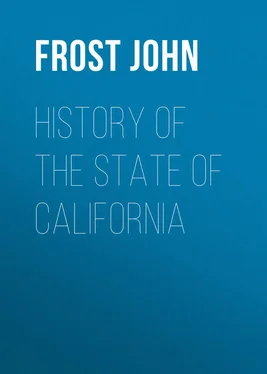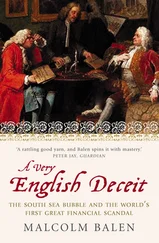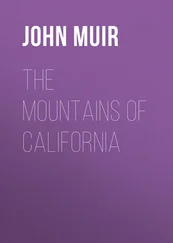John Frost - History of the State of California
Здесь есть возможность читать онлайн «John Frost - History of the State of California» — ознакомительный отрывок электронной книги совершенно бесплатно, а после прочтения отрывка купить полную версию. В некоторых случаях можно слушать аудио, скачать через торрент в формате fb2 и присутствует краткое содержание. Жанр: История, foreign_antique, foreign_prose, на английском языке. Описание произведения, (предисловие) а так же отзывы посетителей доступны на портале библиотеки ЛибКат.
- Название:History of the State of California
- Автор:
- Жанр:
- Год:неизвестен
- ISBN:нет данных
- Рейтинг книги:3 / 5. Голосов: 1
-
Избранное:Добавить в избранное
- Отзывы:
-
Ваша оценка:
- 60
- 1
- 2
- 3
- 4
- 5
History of the State of California: краткое содержание, описание и аннотация
Предлагаем к чтению аннотацию, описание, краткое содержание или предисловие (зависит от того, что написал сам автор книги «History of the State of California»). Если вы не нашли необходимую информацию о книге — напишите в комментариях, мы постараемся отыскать её.
History of the State of California — читать онлайн ознакомительный отрывок
Ниже представлен текст книги, разбитый по страницам. Система сохранения места последней прочитанной страницы, позволяет с удобством читать онлайн бесплатно книгу «History of the State of California», без необходимости каждый раз заново искать на чём Вы остановились. Поставьте закладку, и сможете в любой момент перейти на страницу, на которой закончили чтение.
Интервал:
Закладка:
The Russian American Company had a large establishment at Ross and Bodega, ninety miles north of San Francisco, founded in the year 1812; and factories were also established in the territory by the Hudson Bay Company. Their agents and employes ransacked the whole country west of the Sierra Nevada, or Snowy Mountain, in search of game. In 1838, Captain Sutter, formerly an officer in the Swiss Guards of Charles X., King of France, emigrated from the state of Missouri to Upper California, and obtained from the Mexican government a conditional grant of thirty leagues square of land, bounded on the west by the Sacramento river. Having purchased the stock, arms, and ammunition of the Russian establishment, he erected a dwelling and fortification on the left bank of the Sacramento, about fifty miles from its mouth, and near what was termed, in allusion to the new settlers, the American Fork. This formed the nucleus of a thriving settlement, to which Captain Sutter gave the name of New Helvetia. It is situated at the head of navigation for vessels on the Sacramento, in latitude 38° 33' 45" north, and longitude 121° 20' 05" west. During a residence of ten years in the immediate vicinity of the recently discovered placéras , or gold regions, Captain Sutter was neither the wiser nor the richer for the brilliant treasures that lay scattered around him. 2 2 Farnham's Adventures in California. – Wilkes's Narrative of the Exploring Expedition. – Fremont's Narrative.
In the year 1841, careful examinations of the Bay of San Francisco, and of the Sacramento River and its tributaries, were made by Lieutenant Wilkes, the commander of the Exploring Expedition; and a party under Lieutenant Emmons, of the navy, proceeded up the valley of the Willamette, crossed the intervening highlands, and descended the Sacramento. In 1843-4, similar examinations were made by Captain, afterwards Lieutenant-Colonel Fremont, of the Topographical Engineers, and in 1846, by Major Emory, of the same corps. None of these officers made any discoveries of minerals, although they were led to conjecture, as private individuals who had visited the country had done, from its volcanic formation and peculiar geological features, that they might be found to exist in considerable quantities. 3 3 See Farnham's Adventures. Wilkes's and Fremont's Narratives, and Emory's Report. – In 1846, Eugenio Macnamara, a Catholic priest and Missionary, obtained a grant of a large tract of land between the San Joaquin and the Sierra Nevada, the Cosumnes and the Tulares in the vicinity of San Gabriel, from Pio Pico, governor of the Californias, for the purpose of establishing upon it a large colony of Irish Catholics; but the grant was not ratified by the Central Government, and the project was not carried into effect. There is no evidence that Father Macnamara was aware of the existence of gold in the valley of the San Joaquin.
As is often the case, chance at length accomplished what science had failed to do. In the winter of 1847-8, a Mr. Marshall commenced the construction of a saw-mill for Captain Sutter, on the north branch of the American Fork, and about fifty miles above New Helvetia, in a region abounding with pine timber. The dam and race were completed, but on attempting to put the mill in motion, it was ascertained that the tail-race was too narrow to permit the water to escape with perfect freedom. A strong current was then passed in, to wash it wider and deeper, by which a large bed of mud and gravel was thrown up at the foot of the race. Some days after this occurrence, Mr. Marshall observed a number of brilliant particles on this deposit of mud, which attracted his attention. On examining them, he became satisfied that they were gold, and communicated the fact to Captain Sutter. It was agreed between them, that the circumstance should not be made public for the present; but, like the secret of Midas, it could not be concealed. The Mormon emigrants, of whom Mr. Marshall was one, were soon made acquainted with the discovery, and in a few weeks all California was agitated with the startling information.
Business of every kind was neglected, and the ripened grain was left in the fields unharvested. Nearly the whole population of Upper California became infected with the mania, and flocked to the mines. Whalers and merchant vessels entering the ports were abandoned by their crews, and the American soldiers and sailors deserted in scores. Upon the disbandment of Colonel Stevenson's regiment, most of the men made their way to the mineral regions. Within three months after the discovery, it was computed that there were near four thousand persons, including Indians, who were mostly employed by the whites, engaged in washing for gold. Various modes were adopted to separate the metal from the sand and gravel – some making use of tin pans, others of close-woven Indian baskets, and others still, of a rude machine called the cradle, six or eight feet long, and mounted on rockers, with a coarse grate, or sieve, at one end, but open at the other. The washings were mainly confined to the low wet grounds, and the margins of the streams – the earth being rarely disturbed more than eighteen inches below the surface. The value of the gold dust obtained by each man, per day, is said to have ranged from ten to fifty dollars, and sometimes even to have far exceeded that. The natural consequence of this state of things was, that the price of labor, and, indeed, of every thing, rose immediately from ten to twenty fold. 4 4 Official Despatch of Colonel Mason, Commander of the 10th Military Department, August 17, 1848. – Letters of Thomas C. Larkin, U.S. Consul at Monterey, to the Secretary of State, June 1, and June 28, 1848.
As may readily be conjectured, every stream and ravine in the valley of the Sacramento was soon explored. Gold was found on every one of its tributaries; but the richest earth was discovered near the Rio de los Plumas , or Feather River, 5 5 Feather River is the first considerable branch of the Sacramento below the Prairie Buttes . It has a course of about forty miles, and empties into the main river about fifteen miles above New Helvetia. Though the Sacramento is navigable for vessels only to that place, boats can pass up one hundred miles further.
and its branches, the Yuba and Bear rivers, and on Weber's creek, a tributary of the American Fork. Explorations were also made in the valley of the San Joaquin, which resulted in the discovery of gold on the Cosumnes and other streams, and in the ravines of the Coast Range, west of the valley, as far down as Ciudad de los Angeles.
In addition to the gold mines, other important discoveries were made in Upper California. A rich vein of quicksilver was opened at New Almaden, near Santa Clara, which, with imperfect machinery, – the heat by which the metal is made to exude from the rock being applied by a very rude process, – yielded over thirty per cent. This mine – one of the principal advantages to be derived from which will be, that the working of the silver mines scattered through the territory must now become profitable – is superior to those of Almaden, in Old Spain, and second only to those of Idria, near Trieste, the richest in the world.
Lead mines were likewise discovered in the neighborhood of Sonoma, and vast beds of iron ore near the American Fork, yielding from eighty-five to ninety per cent. Copper, platina, tin, sulphur, zinc, and cobalt, were discovered every where; coal was found to exist in large quantities in the Cascade range of Oregon, of which the Sierra Nevada is a continuation; and in the vicinity of all this mineral wealth, there are immense quarries of marble and granite, for building purposes.
Colonel Mason had succeeded Colonel Fremont in the post of governor of California and military commandant. A regiment of New York troops, under the command of Colonel Stevenson, had been ordered to California before the conclusion of the treaty of peace, and formed the principal part of the military force in the territory.
Читать дальшеИнтервал:
Закладка:
Похожие книги на «History of the State of California»
Представляем Вашему вниманию похожие книги на «History of the State of California» списком для выбора. Мы отобрали схожую по названию и смыслу литературу в надежде предоставить читателям больше вариантов отыскать новые, интересные, ещё непрочитанные произведения.
Обсуждение, отзывы о книге «History of the State of California» и просто собственные мнения читателей. Оставьте ваши комментарии, напишите, что Вы думаете о произведении, его смысле или главных героях. Укажите что конкретно понравилось, а что нет, и почему Вы так считаете.












